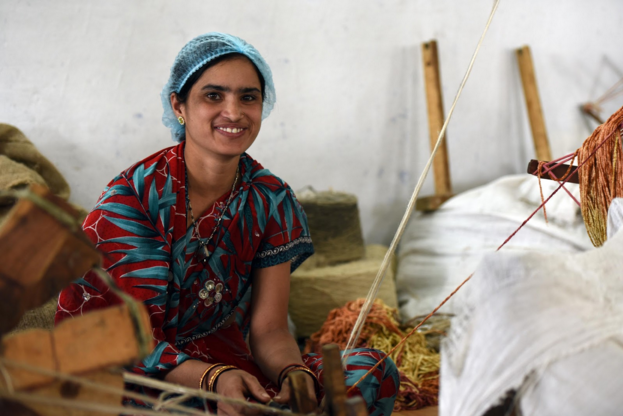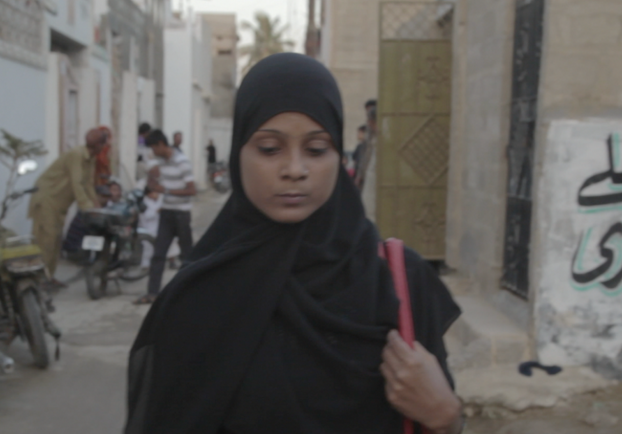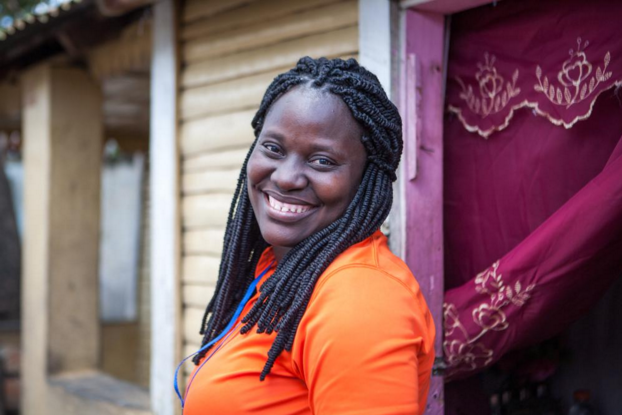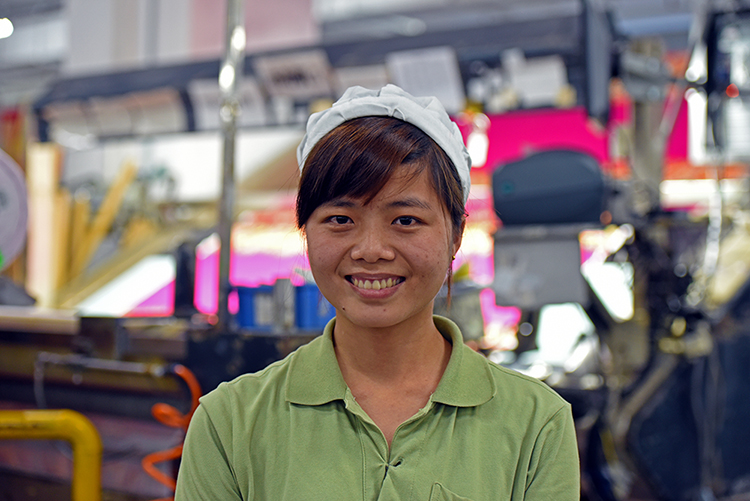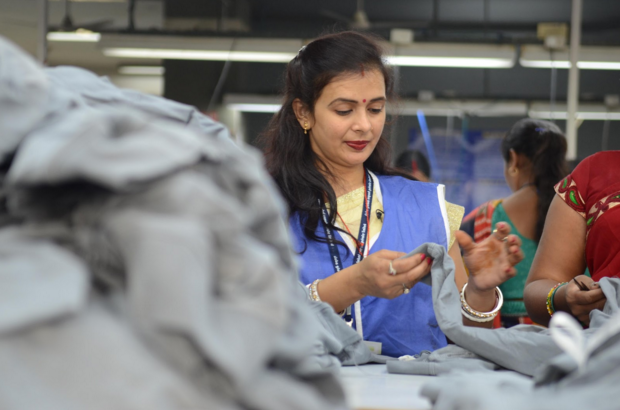80% of our fashion is made by women (mostly 18-24 years old) but we only hear about these millennial makers when they’re associated with a tragedy like Rana Plaza in Bangladesh in 2013 or the infamous Triangle Shirtwaist Factory in New York in 1913. Their stories are eclipsed by heartbreaking headlines that hound the fashion industry.
But there is another part of this story. It’s a story of hope. Remake has traveled to factories and dormitories throughout the world in search of the women who never make the headlines. Kashmiri who opens the yarn to make it into fabric. Maud and Rubina who stitch our blouses and jeans together. Anju who pulls out loose threads and inspects everything to ensure perfection. Each has a story and a hope for a very different future.
Meet the women behind fashion’s supply chain — we followed them from Haiti to Pakistan to China — and asked each of them to share a message to you, the end shopper. These are their stories:
Kashimiri, Yarn opener, Panipat, India
I am 25 years old and already have 4 children. I sit crouched on the floor all day, opening spindles of yarn which go on to become fabric. Panipat has a lot of needs. Open sewers, flies and trash everywhere. Only recently my children starting going to school. I now hope that they will have a better future. Go on to be somebody. I hope you can see their faces in the threads of your fabric.”
Rubina, Hoodie Sewer, Karachi, Pakistan
I am 22 years old and wanted to be a doctor. Then my father got sick, so here I am, many years later, still at a factory stitching college sweatpants and hoodies that go to America. I don’t want you to feel sorry for me. I used to be shy and scared in the factory environment. But after all the injustices I’ve seen happen here, I’ve become a labor organizer. I go to management to demand that we are not harassed, paid on time, given proper food to eat. You would not believe the things I have seen. Stitching all day long my mind wanders and I think about you often. You having fun, wearing these hoodie on campus. I wonder if you think about me ever? The woman who made that for you. I am taking English classes at night. So that one day I can at least get an office job.
Maud, Jeans Sewer, Ouanaminthe, Haiti
The factory across from the Massacre river is like paradise, with its lush green trees and paved roads. I’ve been sitting down sewing your jeans here for five years. Recently my back and neck has been hurting a lot more. But without this job, I have no way to support myself or my six siblings. After a long day, I walked across the river into my community which is pitch dark at night. There is no electricity or running water, just human need everywhere. I want to save enough to go back to university and study computer science. I want you to think about your sister Maud in Haiti, when you put on your jeans. On dark sad nights I play on Facebook with my phone and dream of the day I can be just like you.
Zheng Ming Hui, Quality Assurance, Guangzhou, China
At 19 I left my village to experience the excitement of city life. Here I am three years later, still at the same factory. I work 12 hours a day, looking at beautiful, bright patterns to make sure that there are no defects. My mother wishes I would call her more. But mostly I miss my grandmother. I only get to see my family once a year for Chinese New Year and mom makes the biggest feast. My entire life is the factory. I live in the dorms with three roommates, work all day only stopping to eat at the cafeteria. On my one day off, I am too tired to do much so I play with my phone. At night I dream of bungee jumping. I want to find someone to fall in love with and travel the world for work, taking pictures and telling stories. But for now, I am here, making sure your clothes look nice. I picture you and I am sure you look BEAUTIFUL!
Anju, Fabric Inspection, Delhi, India
I once dreamed of a life that was very different. Where I could finish my education and become a teacher. Everything changed when I was 15 and married to a man with few means. For the last 10 years, I’ve been working in a factory instead. I am proud to be an equal bread winning partner with my husband and to know that my hard work allows my children to go to school. I stand on my feet all day, pulling loose threads out of finished blouses and tops. Making sure they are perfect for you. I want you to know that I recently took a health education course on making nutritious meals with little money. I now teach what I’ve learned at my children’s school on my day off. I guess my dream of becoming a teacher has come true after all.
A 100 pair of human hands touch our clothes before they get to us. Each one of these mothers, sisters, wives and daughters are fierce and hard-working. Dreaming like us to be healthy, happy and financially secure.
Share these stories on Twitter and Facebook with your favorite brands and say: I want to know the invisible people #whomademyclothes.
Together we can #remakeourworld
Ding (left) explains his life philosophy to researcher Mikaela Kvan (right) stating, “I will work until I can’t. That is how I will live my life.” Photo by Daniel Huang
Shenzhen developed earlier than other cities in China so there were many more opportunities to find work here when I first arrived. I came here along with other migrant workers. I didn’t think I would stay here for long but it ended up being 20 years. I have been in Shenzhen for 22 years. Before I married, and when I was young, I lived in cities all across China. I am originally from Jin Jiang in China’s northeastern Jiang Su Province. I go home once a year for the Spring Festival.
I work in garment factories pressing clothes before they are packed for distribution. I’ve had this job on and off over the course of my life. My very first job was as a presser. Soon after, I graduated to a managerial position doing logistics for 20 years. Now I am back to my old job. It’s harder but I have more flexibility and less pressure.

My wife doesn’t live here with me. We used to live together but, when our daughter started junior high school, my wife left to be with her. Our daughter’s teacher called to tell us she was not doing well in school. As parents we want our kids to have a better life than we do and we want them to achieve something. I don’t want her to end up doing physical labor like us.
Now our daughter is 28th in her faculty at university. I am relieved to see her doing so well. She is a good kid and I am proud of her. She studies information engineering at Nanjing University. I’m not sure what her future holds, because it is up to her. She may not be able to make a lot of money because getting rich partly depends on luck.
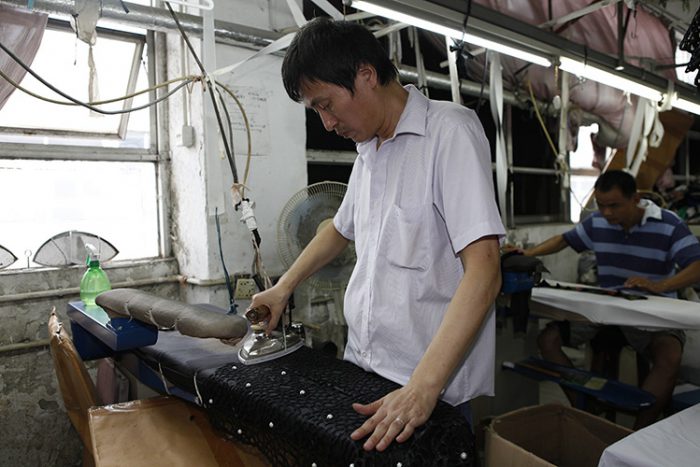
Earlier this year she was selected as one of ten students to study abroad in America. There was a test to select those ten students. Those who aced the test could go. The school will pay for half of the expenses and we will cover the other half. So far, my wife and I can afford it. We are a bit strapped for cash, but I haven’t worked excessively because health is also important to me. If there are orders coming into the factory and us workers have the opportunity for lots of overtime then I can just stay here. However, if there is no overtime at this factory then I will go to other factories to do the same work. I just don’t take any days off. That includes Sunday. I see a bit of myself in my daughter. She is hardworking.
The reason I stay so disciplined in my work is my child. I want to provide for her. I believe you can do anything you want as long as you have money, but you can’t do anything without money. When my kid finds a job, builds her own family and everything is settled for her, only then will I go back to my hometown. I’ll find a job there so my kid doesn’t have to support me. I don’t want to burden her and I want to lift some pressure from her shoulders. I will work until I can’t. That is how I will live my life.
This interview has been edited. It was originally conducted on July 13, 2014, in Yantian, an industrial area east of Shenzhen, China. Read the full story here
Primary Voice is a collection of primary source interviews dedicated to documenting the living stories of garment factory workers worldwide. It was created by urbanist Mikaela Kvan. To read more interviews and to get in touch visit www.primaryvoice.org
22-year-old Huang has been working in garment factories for about five years. Photo by Daniel Huang
I have been working in garment factories for four or five years. I am 22 years old now. When I graduated from junior high school I had nothing to do. Someone told me how good making clothes was and they introduced me to the industry. At that time I thought I was young so it would be good to learn something new. I started to make clothes then and I still do now.
I had many dreams when I was little, such as being a doctor or a policewoman or even being rich. I was so naïve then. Take the doctor dream for example. I am so scared of seeing blood. I once saw someone’s injury from a car accident. OMG, it was terrible. I couldn’t even look at the wound, let alone touch it. I even saw a dead body once. How can I be a doctor if I am so afraid of blood, injuries and death?
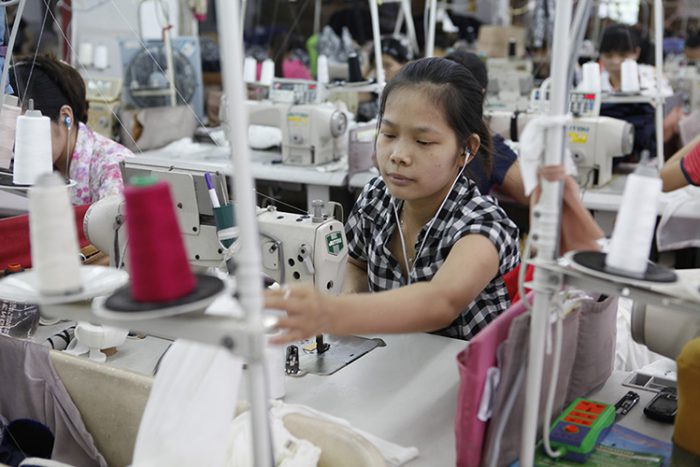
My plan is to work at the garment factory for a few more years but I won’t do it for the rest of my life. I will go back to my hometown to open a store in a few years. I just want to open a store, but I don’t know what kind yet.
When I graduated from junior high school, my mom asked me to keep studying but I didn’t. I was in a dilemma. My mom didn’t want me to work in the city at such a young age. She wanted me to stay in school but I was rebellious. I didn’t do well in school so I thought, “Why bother studying and spending money on my education?” I just came to the city to work so I could support myself. It was a very difficult decision for me. My mom tried to force me to study but I wouldn’t go. Honestly, I regret the decision a bit. I should have gone back to school.
For girls, it is better to learn something not so tough. I think I would learn to make patterns for clothes or something using electronic devices if I could go back to school. I want to learn something easy because I am a lazy person. I like doing finishing work for others so I don’t have to make everything from the beginning.
In terms of social life, garment factory workers like us don’t have time to take a break because we need to do overtime to keep up with production. I go out on public holidays, but there are so many people and cars during that time. I remember I went to a museum park once and I waited in line to get in from 7am to 10 am at the entrance. There were so many people there. For me, having a social life means going out shopping. Girls like shopping and buying cosmetic products. We should spoil ourselves from time to time.
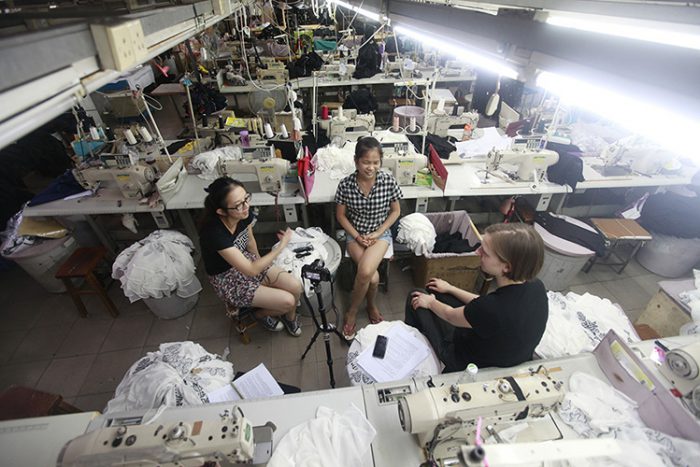
For example, I once spent 2000 RMB (330 USD) to buy a set of Mary Kay products. It is a big brand that I can trust. I buy skin care products instead of make-up. It is important for me to take good care of my skin to look young and pretty because there is dirt and dust around the factory. When I first came to the city, my skin was dark but my skin is getting better with good care. I think it is better to take care of my skin as I grow older. Dirt around the factory may clog the pores in my skin and cause various skin problems. To help, I give myself facials.
Concerning other self-care, I rarely exercise. Firstly, I don’t have much time and secondly, I am too lazy. I will sleep late whenever I have a day off. I am so lazy that I miss the time to exercise. I also hate to wash my clothes because I am lazy. I think it’s best if there is a washing machine but there is no machine so I just wash the clothes myself. When I finish my shower at night, how I wish someone would wash my clothes and I could just lie in bed and play with my phone. But no one is there to help me. Even if I forget about them for half a month, I still have to wash them myself.
This interview has been edited. It was conducted on July 13, 2014 at the factory where Huang works in the industrial area of Yantian east of Shenzhen, China. You can read the original interview here
Primary Voice is a collection of primary source interviews dedicated to documenting the living stories of garment factory workers worldwide. It was created by urbanist Mikaela Kvan. To read more interviews and to get in touch visit www.primaryvoice.org
‘Black Friday’ 2015 is just around the corner. Traditionally it is the day after Thanksgiving in the US when shops do an all-out sale giving the customers a chance to stock up for Christmas. Well that’s what it used to be about. Be it the US or UK, in recent years, ‘Black Friday’ has come to symbolise something more interesting, our insatiable appetite to consume. We all remember seeing the images on TV, hearing the news update on radio and saw the news headlines of the incidences which marred this day. So much so that this year leading UK superstore have announced that they will not be participating in this year’s event even though all other major super stores are[i].
One may well ask, what Black Friday has to do with ‘sustainable development’? One word………..everything! Research after research has found that our demand for goods will soon out strips the natural resources available to make them. We know that in the UK garment workers are earning as little as £3 per hour for their work (University of Leicester Feb 2015[ii]). And those in faraway lands like Bangladesh, Vietnam, Myanmar and even Ethiopia are getting paid approximately £25-30 per month[iii]. But as consumers, we close off part of our thinking mind and all queue up, physically and on-line, waiting for that deal on Black Friday.
Sustainability in the fashion industry has been addressed right through its value and supply chain. In the manufacturing sector of garments, there are all kinds of machinery that optimises water usage for washing and drying of textile and therefore has a knock on effect on the level and amount of electricity and gas used. Buildings are more ‘green’ by using solar power or alternative sources of energy and reuse and recycle rain water amongst other things. More and more manufacturers are also looking more intently on how they engage with their labour force and the provisions that are available for them. Manufacturing factories in Bangladesh are actively pursuing ‘green manufacturing’ starting with the factory space and also the environment and support for their workers[iv].
Worn Again is working with H&M and Kerring[v] to not just recycle or upcycle but create new textile based on a ‘circular resource model’ from old or ‘end of use’ clothes. New materials are also being produced from natural fibers like pineapples or banana and from seed to harvesting all aspects of the plant/ fruit is reused. M&S’s ‘SHWOP’[vi] or Patagonia’s ‘Worn Wear’[vii] are two high profile schemes which promotes and advocates ‘longer-life’ for our clothes. There are workshops on knitting in groups bit like ‘Book Clubs’. Critiques of the schemes say that these schemes are destined for the wardrobes of the rich and middle-classes. Not for the mass public. Also that dropping of our ‘worn’ clothes to the ‘poor’ of the developing nations can actually cause problems for local brands, retailers and manufacturers[viii].
In a recent BBC documentary programme, ‘Hugh’s War on Waste’, the host looks to engage with individuals who do not believe that waste is truly recycled. They are taken to a local recycling processing plant and the sceptic recyclers are still not convinced by the argument for recycling waste. It is only when they are shown actual everyday products made from recycled material that we see the recycling sceptics change their outlook.
But if it is facts we are looking for there is plenty out there in the form of research, films, images, case studies and much more. For instance the recent film ‘The True Cost’[ix] has given a very detailed breakdown of how the fashion supply chain is set up and is costing. It has been distributed in cinemas, is available online and through social media platforms. So very easily available and accessible and we still have the situation of people not following through and buying less or not queuing for ‘Black Friday’.
So far I have concentrated only on the consumption habits of developed countries. However it is the with consumers of China, India and elsewhere that brands and retailers are trying to establish a relationship with. And that is because in emerging countries material consumption lead the way as more people have disposable income and also want to have the opportunity consume or at least aspire to consume as their counter parts in developed countries[x].
So what we see now is brands, luxury brands and every day retailers positioning themselves in these new markets. It is quite normal to see nappies for babies being sold in main cities and towns of these new territories. Long gone are the days when people would use ‘terry cloth’ nappies for their babies not only because they are time consuming to maintain but also they are seen as being ‘traditional’ and not representative of the ‘modern life’ that they now live.
So attitudes are changing everywhere. It’s cyclic. In that the developed world have started thinking about ‘sustainable development’ in all walks of life. They are exploring how corporations, supply chains and individuals can make a difference. The emerging and developing countries with a growing number of people with spending power and disposable income now aspire to consume and become active participants in this global consumer market. Internet has increasingly made everything accessible within a click of a button. Social media shows you trends on a daily, hourly, minute by minute basis to satisfy ones desire.
So the notion of ‘sustainable development’ is admirable but seemingly unachievable. Unless of course as in the case of fashion you have groups like Fashion Revolution Day and their mission to connect consumer to their clothes through the ‘#who made my clothes?’ FRD asks the consumer to do the following:
- Be curious – Look at your clothes with different eyes. Ask more than “does this look great on me?”. Ask “#who made my clothes?”.
- Find out – Get to know your clothes even better.
- Do something – tweaking the way your shop, use and dispose of your clothing
Be curious is the start point of looking at our personal shopping habits. Before we go get the latest design at a cut price from the shop, the question we must ask is ‘do I really need to buy this?’, ‘Will I wear it more than once?’, ‘do I know how to take care of it?’ and what will I do when I have had enough of it?’. These questions are alongside asking the brand ‘#who made my clothes?’ Fashion Revolution has run a very successful global campaign in 2014 and 2015 with consumers, celebrities turning their clothes ‘insideout’ taking a selfie of it and asking the brand ‘#who made my clothes?’
This new curiosity will lead us to the next step ‘Find Out’. If we do not know exactly what is happening then it is difficult to change our behaviours and attitudes. There are various organisations who work on specific issues like living wage, organic cotton or on themes ‘Fair Trade’. They are a good start point for any search[xi]. There are also apps available which will assist you whilst you are shopping to find out more about the social and environmental impact of the item[xii]. New apps are coming are being developed and trialled and aims to provide more detailed information on the item of clothing origin.
‘Do something’ is personally my favourite. It can be you ask the brand, #who made my clothes? Or look at projects like http://loveyourclothes.org.uk/ set up by WRAP which gives you tips on how to manage your clothes, revamp it and much more. As mentioned earlier, high street stores like M&S or brands like Kerring have also tried to inspire their customers with alternatives to just throwing our clothes away. What is possible is sometimes difficult to choose, so a helpful list is available from Fashion Revolution’s booklet, ‘How to be a Fashion Revolutionary’[xiii]
As discussed earlier, the consumer at present is detached from what they consume be it the clothes we wear or other products. We have seen that it is only when they come face to face with evidence, is it that they start to explore further the issues on hand. So that we can move away from the future of diminishing natural resources and an un-sustainable environment we need to change attitudes through curiosity, finding out and doing something.
Author – Maher Anjum – Sustainable Sourcing and Supply Chain (Garments, Textiles and Fashion) Consultant, Operational Director Oitji-jo Collective (Part-Time), Associate Lecturer, London College of Fashion and Member, Global Advisory Committee, Fashion Revolution.
References
[i] http://www.belfasttelegraph.co.uk/news/northern-ireland/asda-axes-black-friday-but-rivals-tesco-sainsburys-amazon-argos-currys-pc-world-halfords-and-john-lewis-banking-on-bonanza-34188894.html
[ii] http://www.theguardian.com/sustainable-business/sustainable-fashion-blog/2015/feb/27/made-in-britain-uk-textile-workers-earning-3-per-hour
[iii] http://www.waronwant.org/sweatshops-bangladesh
[iv] http://www.nytimes.com/2013/03/22/business/energy-environment/conservation-pays-off-for-bangladeshi-factories.html
[v] http://www.kering.com/en/press-releases/hm_kering_and_innovation_company_worn_again_join_forces_to_make_the_continual
[vi] http://www.marksandspencer.com/s/plan-a-shwopping
[vii] http://www.kering.com/en/press-releases/hm_kering_and_innovation_company_worn_again_join_forces_to_make_the_continual
[viii] http://edition.cnn.com/2013/04/12/business/second-hand-clothes-africa/
[ix] http://truecostmovie.com/about/
[x] http://www.worldwatch.org/node/810
[xi] https://www.fashionrevolution.org/wp-content/uploads/2015/11/Website_HTBAFR_Booklet_BCxFR_Print.pdf
[xii] https://www.fashionrevolution.org/wp-content/uploads/2015/11/Website_HTBAFR_Booklet_BCxFR_Print.pdf
[xiii] https://www.fashionrevolution.org/wp-content/uploads/2015/11/Website_HTBAFR_Booklet_BCxFR_Print.pdf
Friday marked the two year anniversary of the devastating collapse of Rana Plaza garment factory in Bangladesh. It also marks the second Fashion Revolution Day, launched last year to commemorate the Rana Plaza disaster with the aims of encouraging greater collaboration across the fashion sector supply chain.
The Rana Plaza disaster has been said to be a “wake up call”, an “eye opener”, a “game changer” and the “end of business as usual” in the global garment supply chain. It has indeed changed the garment industry landscape in Bangladesh and led to many improvements in the fashion supply chain. Western clothing companies, trade unions and the Bangladeshi government have taken steps to improve workplace safety. The legally binding Accord on Fire and Building Safety, run by European brands and retailers, and the Alliance for Bangladesh Worker Safety, led by North American retailers, were formed to ensure safer working conditions at the bottom of the supply chain. A series of inspections in Bangladeshi factories are being conducted, contributing towards better working conditions in Bangladesh and hopefully across fashion supply chains worldwide.
While these developments are encouraging, more needs to be done to accelerate efforts to tackle safety hazards in the factories of low-cost manufacturing countries.
Sedex data shows that more than half (52%) of all issues raised in ethical audits on the Sedex system globally over the past two years are related to health and safety. The highest risks in the garment sector in Bangladesh are related to fire safety: 25% of audits on the Sedex system show problems with fire safety in Bangladesh. Fire safety concerns are also at the top of risks in other garment-producing countries – Pakistan (19%), China (18%) and India (17%) – endangering the lives of workers and posing a big risk to brands, suppliers and investors. Other major risks include building safety, labour rights, working hours, machinery and lack of personal protective equipment & clothing.
The Bangladesh Accord looks predominately at fire and building safety in Bangladesh, but fashion supply chains are affected by many other issues. Garment workers in Bangladesh face poor working conditions and issues around freedom of association, according to the latest report by Human Rights Watch. Countries need to effectively enforce labour laws and ensure that garment workers are able to voice their concerns about safety and working conditions, without fear of being fired, intimidated or assaulted. There is also need to investigate unfair labour practices and ensure workers are paid a living wage.
The garment, textiles, clothing and footwear industry is among the most labour intensive industries, estimated to employ more than 60 million people worldwide. In Bangladesh alone there are more than four million garment workers. But the costs for garment production in Asia are rising, and the garment industry is increasingly moving to other regions, for example Africa. As these new markets are preparing for an influx of new business – building new factories to employ a huge amount of local people – it is crucial to ensure that safety requirements are built in from the very beginning.
The global fashion industry has the power to change its supply chain and positively impact working conditions. Collaboration is key here, amongst Sedex global community we see real progress when buyers and suppliers collaborate between all levels of the supply chain. Leading companies are looking beyond the usual boundaries of responsible sourcing to consider the wider context around responsible sourcing challenges. For example, Marks & Spencer is going outside its factories into communities, working towards empowering women and improving livelihoods of workers.
Change is happening, slowly but steadily. Collaboration among companies, government and, NGOs is essential in delivering improvements in working conditions and ensuring workers well-being throughout global supply chains.
The garment industry is and has historically been one of the most female-dominated industries in the world. Today, more than 70% of garment workers in China are women, in Bangladesh the share is 85%, and in Cambodia as high as 90%[i]. For these women, development is closely linked to their conditions at work. It’s about gaining a decent pay, working under dignified conditions and having basic work security. It’s about moving out of poverty, being able to provide children with education, and to become more independent and grow as an individual.
The reality for most garment workers in the Global South is far from here. Although producing for some of the most profitable companies in the world, they are working for poverty wages, under dreadful conditions, and they have to undertake an excessive amount of overtime. In Bangladesh (the world’s second largest exporter of clothes) the minimum wage for garment workers is 5,300 taka (£45/€62) per month which is far from the 8,900 taka (£75/€104) that are needed to cover a worker’s basic needs, and even further away from a living wage. Many garment workers are working between 60 and 140 hours of overtime per week and it is common to be cheated of the overtime pay. Health and safety are often neglected, workers are denied breaks, and abuses are common – to mention a few of the problems in the industry[ii].
Yet, there are some who argue that this exploitation is the road to female empowerment. Historically, women’s integration into paid work has been one of the important forces to emancipation and growing gender equality. Liberal writers such as Leslie T. Chang, argue that the globalised garment industry has had this empowering effect as women from poor backgrounds are able to find work and earn a salary[iii]. In similar vein, social economist Naila Kabeer emphasises how work in the garment industry has allowed women in Bangladesh to gain recognition for their economic contribution for the family, and that garment workers tend to be more conscious about their rights and have a more critical mindset than other women[iv].
These gains are important to recognise. Still, there are reasons to be sceptical about the transformative potential that garment work has for women in the Global South. Firstly, it is important to understand the way in which women have been integrated to the industry. In the neoliberal deregulated global economy, developing countries are competing to produce for multinational brands by offering the lowest costs and the fastest and most flexible production. In a labour-intensive industry such as garment, this is mainly achieved by making labour cheaper and more flexible, that is, by paying lower salaries, push for longer hours, and reducing work and environmental standards.
Women’s integration to the garment factories has played a crucial role in this process. Factory owners have been taken advantage of women’s unequal position in society to form an even cheaper, more docile and flexible work force. So, rather than challenge their subordination in society, work in the garment industry is reproducing it. Women tend to earn significantly less than men, they face systematic discrimination, and they are only able to access the lowest paid jobs with very poor prospects for promotion. Many of them have low work security, and if they are not prepared to work on the terms set out by their employers they run the risk of losing their jobs[v].
The exploitation of women workers has allowed European fashion companies to make huge profits while denying the workers who produce their clothes the most basic rights. By outsourcing production, these companies are able to both step away from their responsibility and to play producers against each other to get the best and most profitable deal. The deregulated nature of the global economy makes worker’s legal protection very thin and their right to organise and bargain collectively is constantly restricted.
Despite these challenges, there are many women who are mobilising into unions and other labour movements to challenge the inequalities and exploitation in the garment industry. From Bangladesh, to Cambodia and Honduras, workers are defying threats, violence, social oppression and powerful capitalist forces in order to defend their basic rights. Their struggle is key for the development of the workers, their families and whole societies. It also has an important empowering effect for women who commonly are marginalised and discouraged to act politically. This could allow real emancipatory change for women and the chance to move out of poverty and become stronger, more independent individuals.
The citizens of Europe have an important part to play in their struggle. Garment workers need resources and support to confront the powerful forces that they are up against, and there are many organisations that are working on these issues, including Clean Clothes Campaign, War on Want and TRAID. By supporting them we can make an important contribution for the garment workers’ fight. We can also act in solidarity with garment workers by putting pressure on the European firms – notably to pay up for the production and ensure that production is not going to be moved to a new location if labour prices go up. Toothless CSR policies are not enough. We need real commitments from fashion companies and they have to stop counteracting the struggle of garment workers.
Moreover, we must campaign for changes in the global garment industry to stop large fashion retailers from playing producers against each other. Profits can no longer come to any price. Ethics and the environment have to be brought into the centre of the debate and we need to show that, as European citizens, we do not accept the violations that are taking place in the garment industry. European fashion brands should become accountable for the human rights abuses that are taking place in their supply chains, and they should be obliged to ensure that fair wages and work conditions are met. Organisations such as CORE and European Coalition for Corporate Justice are currently campaigning for these changes on national and EU levels, and by supporting them we can make their campaigns grown larger.
Coming back to the initial question of development, the garment industry could have a great potential as an emancipatory force for women in the Global South. However, as we have seen, work in in itself is not sufficient for creating development and challenge gender inequality – the nature of work is as important and this has to be urgently reconsidered. The most important source for that change comes from the garment workers themselves, but the people in Europe has an important role to play by supporting their struggle and campaigning for legislative change on the national and EU levels. Together we can build strength and push for a fairer and sustainable fashion industry.
Emilie Schultze, MSc graduate in Development Studies, SOAS University of London
Photo credits: Rainbow Collective
[i] Rock M. (2001) p. 34 in ‘The rise of the Bangladesh Independent Garment Workers’ Union (BIGU)’ in Hutchison J. and Brown A. (eds.) Organising Labour in Globalising Asia, London and New York: Routledge; Hilary J. (2013) p. 110 in ‘The Poverty of Capitalism: Economic Meltdown and the Struggle for What Comes Next’, Pluto Press: London
[ii] Bloomberg, Bangladesh raises minimum wage for garment workers after unrest. Available at: http://www.bloomberg.com/news/articles/2013-11-13/bangladesh-garment-factories-to-stay-shut-amid-worker-protests
War on Want (2011) p. 4 in Stitched Up: Women workers in the Bangladeshi garment sector, London: War on Want
[iii] Chang L. Ted Talk, The Voices of China’s Workers. Available at https://www.ted.com/talks/leslie_t_chang_the_voices_of_china_s_workers?language=en
[iv] Swedwatch (2012) p. 23-24, A Lost Revolution? Empowered but Trapped in Poverty. Women in the Garment Industry in Bangladesh Want More, Stockholm
[v] WIEGO website, Garment Workers. Available at: http://wiego.org/informal-economy/occupational-groups/garment-workers
